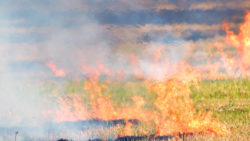Top Class Actions’s website and social media posts use affiliate links. If you make a purchase using such links, we may receive a commission, but it will not result in any additional charges to you. Please review our Affiliate Link Disclosure for more information.

According to a June 5, 2019 article to an article by a local Santa Barbara news source, a Democratic senator from that region—Hannah Beth Jackson–has introduced legislation that will gird up planning requirements in local regions and give municipalities in wildfire areas in California the impetus to strategize fire prevention rather than clean-up after the fact.
As indicated in the report, the fire prevention legislation, Senate Bill 182, managed to pass from the Senate floor to the assembly after garnering three times the number of opposition votes registered. Bill 182 is designed to shore up the protection of high-risk wildfire areas in California by requiring localized planning to fix at-risk structures or have a plan in place to do so in short order.
Additionally, Bill 182 requires planning modification for new building construction which applies wildfire risk reduction to the actual design. Its author also hopes that it will also encourage city governments to build in lower-risk regions first, so as to not compromise housing development goals while addressing the need to reduce strain on fire-prone areas.
Senate Bill 182 also aims to ensure local compliance with the maintenance of defensible space by requiring documentation every three years for properties deemed high-risk. According to the Calfire website, defensible space is a buffer zone between a structure—whether that’s a home or commercial building—and surrounding landscaping such as grassy areas, common area greenbelts, trees, and shrubbery.
As indicated by Calfire, there are two zones—one extending 30 feet and one extending a 100 feet out—from any existing building. While the suggestions for each zone are different, they boil down to trimming trees to keep them from ten feet from each other, a chimney, or the structure itself, and removing any dry pine needles, fallen leaves from deciduous trees, and any dead or dying plants or bushes.
Additionally, it is recommended that outdoor structures such as play-sets, outdoor furniture, and firewood piles be stored with some separation on the grounds.
Senate Bill 182 also encourages home hardening efforts within risky fire areas. In a separate article, Calfire discusses exactly what ‘home hardening’ means—efforts which can also apply to City-owned structures as well as private homes. Home hardening means retrofitting vulnerable areas of a structure with more modern materials that are fire-resistant. Instead of keeping an old cedar shake roof, efforts to remove that and replace it with a new composite or metal tiles are a good example of hardening.
Another example would be to cover vents—where embers could gain access to the home from a nearby fire—with fine metal mesh. Installing double-paned tempered glass in windows is also critical in stopping the spread of fire. If windows break, embers can get in and cause fire to spread more easily.
Building materials more suitable to a fire-prone area such as stucco, fiber cement, or treated wood are also recommended as part of a more comprehensive retrofit of a home or building. Fences and decking need to be made of ignition-resistant materials as well. Items stored in and around these areas must be non-combustible as well.
Senator Hannah Beth Jackson—who introduced Senate Bill 182—recognizes that homeowners and municipalities cannot go on behaving in the same ill-prepared way after all the devastating wildfires that destroyed houses, killed people, and cost millions. She is hopeful the bill is a good start in pointing us in the right direction.
Join a Free California Wildfire Property Damage Lawsuit Investigation
If you or a loved one suffered property damage in the Camp Fire, Woolsey Fire, Hill Fire or last year’s Thomas Fire, legal help is available to help you through the claim process with your insurance company.
This article is not legal advice. It is presented
for informational purposes only.
ATTORNEY ADVERTISING
Top Class Actions is a Proud Member of the American Bar Association
LEGAL INFORMATION IS NOT LEGAL ADVICE
Top Class Actions Legal Statement
©2008 – 2024 Top Class Actions® LLC
Various Trademarks held by their respective owners
This website is not intended for viewing or usage by European Union citizens.
Get Help – It’s Free
Join a Free California Wildfire Property Damage Lawsuit Investigation
If you qualify, an attorney will contact you to discuss the details of your potential case at no charge to you.
PLEASE NOTE: If you want to participate in this investigation, it is imperative that you reply to the law firm if they call or email you. Failing to do so may result in you not getting signed up as a client or getting you dropped as a client.
E-mail any problems with this form to:
Questions@TopClassActions.com.
Oops! We could not locate your form.












